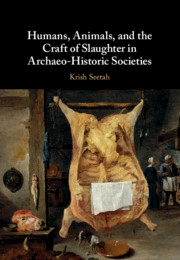Book contents
- Humans, Animals, and the Craft of Slaughter in Archaeo-Historic Societies
- Humans, Animals, and the Craft of Slaughter in Archaeo-Historic Societies
- Copyright page
- Contents
- Figures
- Tables
- Preface
- Acknowledgements
- Part I Butchery as Craft and Social Praxis
- Part II The Practice of Butchery in Archaeo-Historic Societies
- Notes
- References
- Index
- References
References
Published online by Cambridge University Press: 08 October 2018
- Humans, Animals, and the Craft of Slaughter in Archaeo-Historic Societies
- Humans, Animals, and the Craft of Slaughter in Archaeo-Historic Societies
- Copyright page
- Contents
- Figures
- Tables
- Preface
- Acknowledgements
- Part I Butchery as Craft and Social Praxis
- Part II The Practice of Butchery in Archaeo-Historic Societies
- Notes
- References
- Index
- References
Summary

- Type
- Chapter
- Information
- Publisher: Cambridge University PressPrint publication year: 2018



